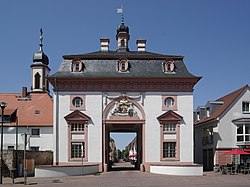Gate construction (Heusenstamm)
The gate building in Heusenstamm in Hesse is a triumphal arch-like structure built in 1764 and is located at the southern entrance to the old town. It was built by Count Eugen Erwein von Schönborn to commemorate the seven-day visit of the designated German Emperor, Joseph II. As a city gate.
prehistory
After the Seven Years' War ended in 1763 with the Hubertusburg Peace Agreement, the election of the new Emperor Josef was decided to seal it. The Heusenstammer counts Schönborn traditionally had close ties to the Habsburg court in Vienna . Since neither the incumbent nor the designated emperor was allowed to be present at the election ceremony in Frankfurt , Emperor Franz I and his sons Josef and Leopold and his entourage spent the seven-day waiting period as guests of Count von Schönborn in Heusenstamm from March 23 to 29, 1764 . To entertain the high-ranking guests, a large wooden pavilion was built in the courtyard of Schönborn's Palace , the so-called “Imperial Hall”. Garden festivals, fireworks and musical performances for rulers and people were offered there over several days. The wooden pavilion was demolished at the beginning of the 19th century because it was dilapidated.
History of gate construction
In memory of the seven-day events and in honor of the high-ranking guests, Count Eugen Erwein von Schönborn had the old southern city gate replaced with the archway in the same year. The archway was built with four floors and allowed the passage of carriages and wagons . The gate construction formed the entrance and exit to the country road from Seligenstadt to Frankfurt, which is still today an important traffic connection in Heusenstamm as Frankfurter Straße. The gate was originally inserted into the city wall on the right and left sides of the wing. The Schönborn house coat of arms, which is held by two lions, is affixed above the gate entrance on the south side. Below is the Latin inscription: “ Up. Imp. Franc. I. quo eligebatur filius Josephus in regem rome. VII. Dierum tempore hic hospitis in honorem hanc portam exstrui fecit fidem a. cons. int. Eu. Erw. Comes a Schoenborn Anno MDCCLXIV ”(German:“ In honor of Emperor Franz I, whose son Joseph was elected King of Rome on the 7th day of his hospitality, this portal was built by Eugen Erwein Graf von Schönborn in 1764 ”).
Gate guards and community gendarmes lived on the upper floors, later apartments were set up there for the needy and shepherds. The Heusenstammer idiom comes from this time: “Get on goal” or “Get on goal”, which symbolizes impoverishment. Today the archway houses part of the local museum of local history.
The gate construction was donated to the community of Heusenstamm in 1853. In the deed of gift dated August 9, 1853, the community was obliged to maintain it. The first renovation took place in 1894, a complete renovation in 1960 and a comprehensive exterior renovation was carried out after 2000.
Web links
- History and descriptions of the gate construction on the homepage of the town of Heusenstamm
- Description on the website museum-in-hessen
Coordinates: 50 ° 3 ′ 34.1 ″ N , 8 ° 48 ′ 24.4 ″ E



